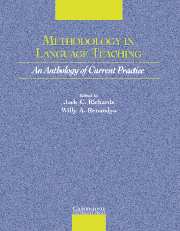Book contents
- Frontmatter
- Contents
- Acknowledgments
- Introduction
- Section I Approaches to Teaching
- Section 2 Lesson Planning and Classroom Management
- Section 3 Classroom Dynamics
- Section 4 Syllabus Design and Instructional Materials
- Section 5 Task and Project Work
- Section 6 Learning Strategies
- Section 7 Teaching Grammar
- Chapter 13 Seven Bad Reasons for Teaching Grammar – and Two Good Ones
- Chapter 14 Addressing the Grammar Gap in Task Work
- Chapter 15 Grammar Teaching – Practice or Consciousness-Raising?
- Section 8 Teaching Pronunciation
- Section 9 Teaching Speaking
- Section 10 Teaching Listening
- Section 11 Teaching Vocabulary
- Section 12 Teaching Reading
- Section 13 Teaching Writing
- Section 14 Assessment
- Section 15 Technologies in the Classroom
- Section 16 Professional Development
- Credits
- Author Index
- Subject Index
- References
Chapter 15 - Grammar Teaching – Practice or Consciousness-Raising?
Published online by Cambridge University Press: 10 November 2010
- Frontmatter
- Contents
- Acknowledgments
- Introduction
- Section I Approaches to Teaching
- Section 2 Lesson Planning and Classroom Management
- Section 3 Classroom Dynamics
- Section 4 Syllabus Design and Instructional Materials
- Section 5 Task and Project Work
- Section 6 Learning Strategies
- Section 7 Teaching Grammar
- Chapter 13 Seven Bad Reasons for Teaching Grammar – and Two Good Ones
- Chapter 14 Addressing the Grammar Gap in Task Work
- Chapter 15 Grammar Teaching – Practice or Consciousness-Raising?
- Section 8 Teaching Pronunciation
- Section 9 Teaching Speaking
- Section 10 Teaching Listening
- Section 11 Teaching Vocabulary
- Section 12 Teaching Reading
- Section 13 Teaching Writing
- Section 14 Assessment
- Section 15 Technologies in the Classroom
- Section 16 Professional Development
- Credits
- Author Index
- Subject Index
- References
Summary
INTRODUCTION
Two major questions need to be considered with regard to grammar teaching in second language (L2) pedagogy:
Should we teach grammar at all?
If we should teach grammar, how should we teach it?
The first question has been answered in the negative by some applied linguists. Krashen (1982), for instance, has argued that formal instruction in grammar will not contribute to the development of ‘acquired’ knowledge – the knowledge needed to participate in authentic communication. Prabhu (1987) has tried to show, with some success, that classroom learners can acquire an L2 grammar naturalistically by participating in meaning-focused tasks. Others, however, including myself, have argued that grammar teaching does aid L2 acquisition, although not necessarily in the way teachers often think it does. My principal contention is that formal grammar teaching has a delayed rather than instant effect.
The focus of this article is the second question. I am going to assume that we should teach grammar (see Ellis, 1990, for the reasons why) and turn my attention to how we should set about doing so. Specifically, I want to consider two approaches, which I shall refer to as ‘practice’ and ‘consciousness-raising’. I shall begin by defining these. I will then briefly consider the case for practice and argue that the available evidence suggests that it may not be as effective as is generally believed. I will then present a number of arguments in support of consciousness-raising and conclude with an example of a ‘CR-task’.
Information
- Type
- Chapter
- Information
- Methodology in Language TeachingAn Anthology of Current Practice, pp. 167 - 174Publisher: Cambridge University PressPrint publication year: 2002
References
Accessibility standard: Unknown
Why this information is here
This section outlines the accessibility features of this content - including support for screen readers, full keyboard navigation and high-contrast display options. This may not be relevant for you.Accessibility Information
- 46
- Cited by
